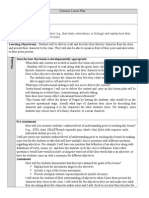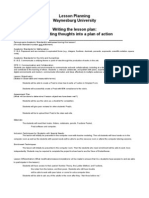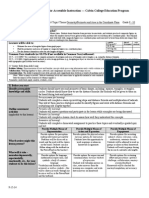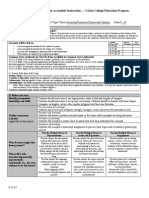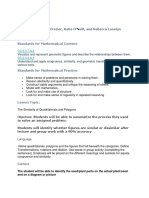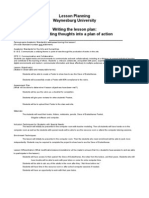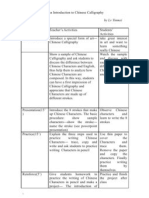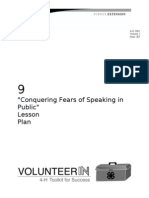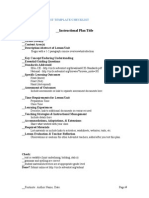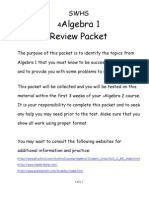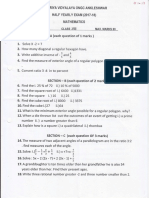Adding Fractions
Uploaded by
William BaileyAdding Fractions
Uploaded by
William BaileyNestor Perez Spring 2007 MAEU 6327
Adding Fractions Overview
Unit Name: Operations With Fractions Name of Lesson: Adding Fractions Author: Nestor Perez Grade Level: 7th Grade Lesson Time Frame: 50 minutes Classroom Layout: Group students in pairs, with access to a computer per group. Prerequisite Knowledge for Students: Technology: Familiarity with computer, opening up a program, opening up a file. Math: Familiar with concept of adding, multiplying, and dividing integers. Familiar with mixed numbers. Prerequisite Knowledge for Teacher: Technology: Working knowledge with computer/computer cart, familiar with Excel program, familiar with web browser. Math: Knowledge of core concepts of adding, multiplying, and dividing integers and how this applies to fractions. Objectives of the Lesson: With this lesson the students will be able to have a hands-on experience in the exploration of the concept of adding fractions. Instead of simply memorizing rules or steps necessary to add fractions, the students will, with the help of technology, be able to visually appreciate the effects of changing values in the fractions. At the end of the lesson the students will be able to: a) convert fractions to equivalent fractions with a common denominator b) add fractions with a common denominator c) simplify fractions to mixed numbers List of Materials: Teacher: Computer, projector, access to computers with Excel installed in them for student use. Students: Calculators, paper and pencil for observations Description of Content of Lesson: The lesson consists of two parts. First, a PowerPoint presentation to introduce the concept of adding fractions to the students wherein the teacher develops the concepts of numerators and denominators being the parts that make-up a fraction. The presentation then proceeds to walk the students through the process of finding common denominators, converting fractions into equivalent fractions, adding numerators while keeping the common denominator, and lastly simplifying the fraction if necessary.
Nestor Perez Spring 2007 MAEU 6327 The second part of the lesson is having the students derive a first-hand experience in adding fractions through the use of an Excel spreadsheet. The spreadsheet is constructed so that the students can change values in the fraction through the use of sliders one slider for each numerator and denominator. As the student is learning the concept, the possible choice in numbers has been limited to numbers 0 10 for the numerator, and 1-10 for the denominator to avoid division by 0. When the student changes a value in a fraction with one of the sliders, the program automatically recalculates the value of the added fraction and simplifies it. Sunshine State Standards: MA.A.3.3.1 Understands and explains the effects of addition, subtraction, multiplication, and division on whole numbers, fractions, including mixed numbers, and decimals, including the inverse relationships of positive and negative numbers. MA.A.3.3.2 Selects the appropriate operation to solve problems involving addition, subtraction, multiplication, and division of rational numbers, ratios, proportions, and percents, including the appropriate application of the algebraic order of operations.
Key Words: Numerator Denominator Common Denominator Ratio Equivalent Fractions
Nestor Perez Spring 2007 MAEU 6327
Lesson Plan Introduction to the lesson: Historical background: The word fraction comes from the Latin word fractio which means to break. Fractions were used as early as 1800 B.C. by the Egyptians, which wrote fractions of their base 10 system, similar to our own, in hieroglyphics. The Egyptians expressed all their fractions as unit fractions (with a numerator of one), and represented their fractions as additions of unit fractions without repeating the same unit fraction in the addition. The ancient Romans also used fractions using a base 12 for their units, which also made computations with fractions cumbersome. The Babylonians used fractions about the same time as the Romans, but their number system was based around the number 60 (base 60). By about 500 AD the Indians had developed a number system that consisted of nine symbols and a zero. They used the fractions in much the same form we do now except they did not use the line to separate the numerator and denominator. With the trade between the Indian and Arabs, the number system used of nine symbols and a zero was propagated to the Middle East, and the Arabs introduced the line used to separate the numerator and denominator, which is the form we use today to write fractions. Anticipatory set: You can get set the stage for the discussion of fractions by pointing out how prevalent fractions are in everyday life. Talk about the distance students live from school, ingredients used in a cooking recipe, sharing a candy bar between friends, etc. Any of these topics will lead to the discussion of fractions. Relate Lesson to Previous Learning and/or Life Experience: One of the common experiences that can be drawn on to discuss fractions is making change:, which all students are familiar with. Any time we make change we are working with a fraction of a unit. Start by representing various fractions; such as 1/10, 3/10, , etc, and proceed to add fractions to show students the process of addition. Explanation of the Math Involved: The purpose of this lesson is to have students add positive fractions. In order to add fractions, students must first obtain a common denominator for the fractions involved. Once a common denominator is obtained, they will convert the fractions into equivalent fractions with a common denominator. The next step is add the numerators, while keeping the common denominator, and finally, if necessary, simplify the fraction to its lowest terms.
Nestor Perez Spring 2007 MAEU 6327 Instructional Method: This lesson is based on a student centered approach. The lesson consists of students using a simulation program to investigate how fractions are added by means of changing the value of the fractions through the use of sliders on a spreadsheet. After changing the values of one or both fractions, students will log their observations on how the program converts the fractions into equivalent fractions with common denominators, as well as the resulting fractions, as well as the simplified fraction if the teacher so desires. Step by Step Procedure: In order to present this lesson the following steps should be followed: o Set up computers for the students to use with the spreadsheet already loaded in the computers. o Group the students as needed, depending on number of computers available, to enable all students to experiment with the selection of fractions in the program and jot down their observations. o Guide students in opening the program (Excel), and locate the spreadsheet to be used. o Allow the students to use the sliders to change the value of the fractions and observe the results while answering the questions listed at the bottom of the page. * Key Questions to be Asked: What is a fraction? In your experience, when have you used fractions in everyday life? When you go to the store and buy something, is the change you receive related to fractions? When you share something with a friend, are you using fractions? * Closure to the Lesson: After the students have had an opportunity to explore addition of fractions with the spreadsheet, the teacher can use the included PowerPoint presentation to reinforce the concept with the students. At the teacher discretion, the PowerPoint presentation can be used before the students explore the concept with the spreadsheet. Assignment for the Students: As a follow up, you can assign students problems from the textbook being used that deal with adding fractions. Assessments: The teacher can asses the students at the end of the lesson, as time permits by asking relevant questions regarding the activity the students just participated in. Instructional Materials: The instructional materials for the teacher consist of the Excel spreadsheet for the students to use, along with the PowerPoint presentation. Instructional material for the students consists of the spreadsheet they will work with, along with paper, pencil, and a calculator to perform operations.
You might also like
- Chinese Calligraphy and Four Treasures - Lesson Plan: Subject: Other - World Languages/ChineseNo ratings yetChinese Calligraphy and Four Treasures - Lesson Plan: Subject: Other - World Languages/Chinese2 pages
- Kutztown University Elementary Education Department Professional Semester Program Lesson Plan FormatNo ratings yetKutztown University Elementary Education Department Professional Semester Program Lesson Plan Format7 pages
- Tutorial Letter 102/3/2013: Health EducationNo ratings yetTutorial Letter 102/3/2013: Health Education39 pages
- Lesson 2 Perimeter and Area in The Coordinate PlaneNo ratings yetLesson 2 Perimeter and Area in The Coordinate Plane3 pages
- Digital Unit Plan Template Unit Title: Cooking With Fractions Name: Susan Mejia Content Area: Mathematics Grade Level: 5 - 6No ratings yetDigital Unit Plan Template Unit Title: Cooking With Fractions Name: Susan Mejia Content Area: Mathematics Grade Level: 5 - 66 pages
- Lesson Makeover Assignment: Andrea NanceNo ratings yetLesson Makeover Assignment: Andrea Nance4 pages
- Lesson Plan: Step 1: Curriculum ConnectionsNo ratings yetLesson Plan: Step 1: Curriculum Connections4 pages
- Daily Lesson Plan A. Deelstra: Math: Number Sense and Numeration 6No ratings yetDaily Lesson Plan A. Deelstra: Math: Number Sense and Numeration 63 pages
- EDUC 2220-Educational Technology Lesson Plan Andrea Ray: Common Core StandardsNo ratings yetEDUC 2220-Educational Technology Lesson Plan Andrea Ray: Common Core Standards5 pages
- Unit Title: Algebra I Name: Quynhnhu Cao Content Area: Algebra 1P Grade Level:9 Grade Level CA Content Standard(s) /common Core Standard(s)No ratings yetUnit Title: Algebra I Name: Quynhnhu Cao Content Area: Algebra 1P Grade Level:9 Grade Level CA Content Standard(s) /common Core Standard(s)4 pages
- Kincaid Ed 124 Final Project Development Instruction AssessmentNo ratings yetKincaid Ed 124 Final Project Development Instruction Assessment11 pages
- Lesson Plan Template Unit/Topic: - Lesson # - Strand(s) : - Level: - OutcomesNo ratings yetLesson Plan Template Unit/Topic: - Lesson # - Strand(s) : - Level: - Outcomes3 pages
- Unit 3 Lesson Plan Developed For Grade(s) 6 Title: What Is An Urban Heat Island? Author: Barbara WilliamsNo ratings yetUnit 3 Lesson Plan Developed For Grade(s) 6 Title: What Is An Urban Heat Island? Author: Barbara Williams2 pages
- Digital Photography History Lesson ActivityNo ratings yetDigital Photography History Lesson Activity1 page
- Keyboarding Lesson Plan With Test ReflectionNo ratings yetKeyboarding Lesson Plan With Test Reflection1 page
- Conquering Fears of Speaking in Public Lesson PlanNo ratings yetConquering Fears of Speaking in Public Lesson Plan16 pages
- Instructional Plan Title: Circle Lesson/Unit Template/ChecklistNo ratings yetInstructional Plan Title: Circle Lesson/Unit Template/Checklist1 page
- 6.N.14 Accurately and Efficiently Add, Subtract, Multiply, and Divide Positive Fractions and Mixed Numbers. Simplify FractionsNo ratings yet6.N.14 Accurately and Efficiently Add, Subtract, Multiply, and Divide Positive Fractions and Mixed Numbers. Simplify Fractions5 pages
- Ks2 Mathematics 2011 Level 6 Marking SchemeNo ratings yetKs2 Mathematics 2011 Level 6 Marking Scheme28 pages
- Zany World of Basic Math The Module 8 Adding and Subtracting FractionsNo ratings yetZany World of Basic Math The Module 8 Adding and Subtracting Fractions11 pages
- Expressions and Equations Stinky Feet Review Game (Sub Plans)No ratings yetExpressions and Equations Stinky Feet Review Game (Sub Plans)17 pages
- Project in Math 9: Word Problem Solving Involving Ratios and ProportionsNo ratings yetProject in Math 9: Word Problem Solving Involving Ratios and Proportions5 pages
- Nature, The Golden Ratio and Fibonacci Numbers100% (1)Nature, The Golden Ratio and Fibonacci Numbers7 pages
- On The Histories of Linear Algebra The Case of Linear Systems100% (1)On The Histories of Linear Algebra The Case of Linear Systems28 pages
- Chinese Calligraphy and Four Treasures - Lesson Plan: Subject: Other - World Languages/ChineseChinese Calligraphy and Four Treasures - Lesson Plan: Subject: Other - World Languages/Chinese
- Kutztown University Elementary Education Department Professional Semester Program Lesson Plan FormatKutztown University Elementary Education Department Professional Semester Program Lesson Plan Format
- Lesson 2 Perimeter and Area in The Coordinate PlaneLesson 2 Perimeter and Area in The Coordinate Plane
- Digital Unit Plan Template Unit Title: Cooking With Fractions Name: Susan Mejia Content Area: Mathematics Grade Level: 5 - 6Digital Unit Plan Template Unit Title: Cooking With Fractions Name: Susan Mejia Content Area: Mathematics Grade Level: 5 - 6
- Daily Lesson Plan A. Deelstra: Math: Number Sense and Numeration 6Daily Lesson Plan A. Deelstra: Math: Number Sense and Numeration 6
- EDUC 2220-Educational Technology Lesson Plan Andrea Ray: Common Core StandardsEDUC 2220-Educational Technology Lesson Plan Andrea Ray: Common Core Standards
- Unit Title: Algebra I Name: Quynhnhu Cao Content Area: Algebra 1P Grade Level:9 Grade Level CA Content Standard(s) /common Core Standard(s)Unit Title: Algebra I Name: Quynhnhu Cao Content Area: Algebra 1P Grade Level:9 Grade Level CA Content Standard(s) /common Core Standard(s)
- Kincaid Ed 124 Final Project Development Instruction AssessmentKincaid Ed 124 Final Project Development Instruction Assessment
- Lesson Plan Template Unit/Topic: - Lesson # - Strand(s) : - Level: - OutcomesLesson Plan Template Unit/Topic: - Lesson # - Strand(s) : - Level: - Outcomes
- Unit 3 Lesson Plan Developed For Grade(s) 6 Title: What Is An Urban Heat Island? Author: Barbara WilliamsUnit 3 Lesson Plan Developed For Grade(s) 6 Title: What Is An Urban Heat Island? Author: Barbara Williams
- Conquering Fears of Speaking in Public Lesson PlanConquering Fears of Speaking in Public Lesson Plan
- Instructional Plan Title: Circle Lesson/Unit Template/ChecklistInstructional Plan Title: Circle Lesson/Unit Template/Checklist
- 6.N.14 Accurately and Efficiently Add, Subtract, Multiply, and Divide Positive Fractions and Mixed Numbers. Simplify Fractions6.N.14 Accurately and Efficiently Add, Subtract, Multiply, and Divide Positive Fractions and Mixed Numbers. Simplify Fractions
- Zany World of Basic Math The Module 8 Adding and Subtracting FractionsZany World of Basic Math The Module 8 Adding and Subtracting Fractions
- Expressions and Equations Stinky Feet Review Game (Sub Plans)Expressions and Equations Stinky Feet Review Game (Sub Plans)
- Project in Math 9: Word Problem Solving Involving Ratios and ProportionsProject in Math 9: Word Problem Solving Involving Ratios and Proportions
- On The Histories of Linear Algebra The Case of Linear SystemsOn The Histories of Linear Algebra The Case of Linear Systems

